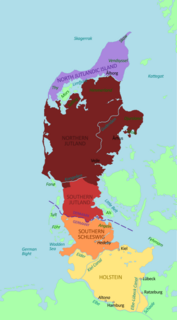Jannik Petersen Bjerrum (26 December 1851 – 2 July 1920) was a Danish ophthalmologist who was a native of Skærbæk, a town in the southernmost part of Jutland. [1] In 1864 Skærbæk became part of Germany due to consequences of the Second Schleswig War.
Skærbæk is a town with a population of 3,062 and a former municipality on the coast of Tønder municipality in Region of Southern Denmark on the Jutland peninsula in south Denmark. The former Skærbæk municipality covered an area of 360 square kilometres (140 sq mi) and had a total population of 7,294 (2005).

Jutland, also known as the Cimbric or Cimbrian Peninsula, is a peninsula of Northern Europe that forms the continental portion of Denmark and part of northern Germany. The names are derived from the Jutes and the Cimbri, respectively.

The Second Schleswig War was the second military conflict over the Schleswig-Holstein Question of the nineteenth century. The war began on 1 February 1864, when Prussian forces crossed the border into Schleswig. Denmark fought the Kingdom of Prussia and the Austrian Empire. Like the First Schleswig War (1848–52), it was fought for control of the duchies of Holstein and Lauenburg, due to the succession disputes concerning them when the Danish king died without an heir acceptable to the German Confederation. Controversy arose due to the passing of the November Constitution, which integrated the Duchy of Schleswig into the Danish kingdom in violation of the London Protocol. Reasons for the war were the ethnic controversy in Schleswig and the co-existence of conflicting political systems within the Danish unitary state.
In 1876 he received his medical doctorate from the University of Copenhagen, and in 1879 became an assistant to Edmund Hansen Grut (1831-1907) at the Havnegade eye clinic. After Grut's retirement in 1896, he became director of the clinic, as well as being the second professor of ophthalmology at the University of Copenhagen, a position he would maintain until his retirement in 1910.

The University of Copenhagen (UCPH) is the oldest university and research institution in Denmark. Founded in 1479 as a studium generale, it is the second oldest institution for higher education in Scandinavia after Uppsala University (1477). The university has 23,473 undergraduate students, 17,398 postgraduate students, 2,968 doctoral students and over 9,000 employees. The university has four campuses located in and around Copenhagen, with the headquarters located in central Copenhagen. Most courses are taught in Danish; however, many courses are also offered in English and a few in German. The university has several thousands of foreign students, about half of whom come from Nordic countries.
Edmund Hansen Grut was a Danish ophthalmologist born in Copenhagen.

Ophthalmology is a branch of medicine and surgery that deals with the diagnosis and treatment of eye disorders. An ophthalmologist is a specialist in ophthalmology. Their credentials include a degree in medicine, followed by an additional four years of ophthalmology residency training. They may or may not receive residency training in internal medicine, pediatrics, or general surgery before the ophthalmology residency. Additional training may be sought through a fellowship in a particular specialty of eye pathology. Ophthalmologists are allowed to use medications to treat eye diseases, implement laser therapy, and perform surgery when needed. Ophthalmologists may participate in academic research on the diagnosis and treatment for eye disorders.
Bjerrum made contributions regarding pathogenetic research of glaucoma, and performed extensive investigations involving campimetry. He was interested in the correlation between visual perception of form and the resolving power in localized regions of the retina. He was particularly focused on the subtleties of the central 30° of the visual field rather than the standard perimetry tests that many of his contemporaries favored.
The pathogenesis of a disease is the biological mechanism progress of disease showing its morphological features or that leads to the diseased state. The term can also describe the origin and development of the disease, and whether it is acute, chronic, or recurrent. The word comes from the Greek πάθος pathos and γένεσις genesis ("creation").

Glaucoma is a group of eye diseases which result in damage to the optic nerve and vision loss. The most common type is open-angle glaucoma with less common types including closed-angle glaucoma and normal-tension glaucoma. Open-angle glaucoma develops slowly over time and there is no pain. Peripheral vision may begin to decrease followed by central vision resulting in blindness if not treated. Closed-angle glaucoma can present gradually or suddenly. The sudden presentation may involve severe eye pain, blurred vision, mid-dilated pupil, redness of the eye, and nausea. Vision loss from glaucoma, once it has occurred, is permanent.

The retina is the innermost, light-sensitive layer of tissue of the eye of most vertebrates and some molluscs. The optics of the eye create a focused two-dimensional image of the visual world on the retina, which translates that image into electrical neural impulses to the brain to create visual perception, the retina serving a function analogous to that of the film or image sensor in a camera.
As a result of his campimetric tests he discovered a small glaucomatous scotoma that was to become known as a "Bjerrum scotoma", which is a visual field defect that goes by several other names, such as "sickle scotoma", "arcuate scotoma" or "scimitar scotoma". Other eponyms named after Bjerrum include:

A scotoma is an area of partial alteration in the field of vision consisting of a partially diminished or entirely degenerated visual acuity that is surrounded by a field of normal – or relatively well-preserved – vision.
- Bjerrum tangent screen: Screen used to assess the central 30° of the visual field.
- Bjerrum's area: An arcuate region that extends above and below the blind spot to between 10° and 20° of fixation point.

Bjerrum's area is the central 25° of the visual field from the fixation point, popularized scientifically by the Danish ophthalmologist Jannik Petersen Bjerrum.

A blind spot, scotoma, is an obscuration of the visual field. A particular blind spot known as the physiological blind spot, "blind point", or punctum caecum in medical literature, is the place in the visual field that corresponds to the lack of light-detecting photoreceptor cells on the optic disc of the retina where the optic nerve passes through the optic disc. Because there are no cells to detect light on the optic disc, the corresponding part of the field of vision is invisible. Some process in our brains interpolates the blind spot based on surrounding detail and information from the other eye, so we do not normally perceive the blind spot.

Fixation or visual fixation is the maintaining of the visual gaze on a single location. An animal can exhibit visual fixation if they possess a fovea in the anatomy of their eye. The fovea is typically located at the center of the retina and is the point of clearest vision. The species in which fixational eye movement has been found thus far include humans, primates, cats, rabbits, turtles, salamanders, and owls. Regular eye movement alternates between saccades and visual fixations, the notable exception being in smooth pursuit, controlled by a different neural substrate that appears to have developed for hunting prey. The term "fixation" can either be used to refer to the point in time and space of focus or the act of fixating. Fixation, in the act of fixating, is the point between any two saccades, during which the eyes are relatively stationary and virtually all visual input occurs. In the absence of retinal jitter, a laboratory condition known as retinal stabilization, perceptions tend to rapidly fade away. To maintain visibility, the nervous system carries out a mechanism called fixational eye movement, which continuously stimulates neurons in the early visual areas of the brain responding to transient stimuli. There are three categories of fixational eye movements: microsaccades, ocular drifts, and ocular microtremor. Although the existence of these movements has been known since the 1950s, only recently their functions have started to become clear.
After Bjerrum's retirement in 1910, his work in campimetry was continued by his assistant, Henning Rønne (1878-1947).
Henning Rønne was a Danish ophthalmologist.
Jannik Petersen Bjerrum was the father of the chemist Niels Bjerrum and the brother of physicist Kirstine Meyer.






